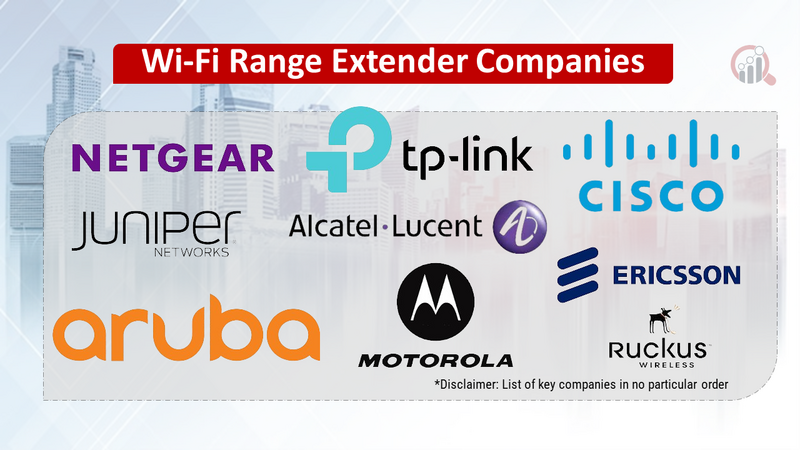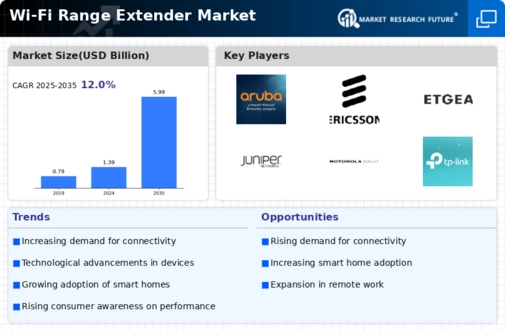Top Industry Leaders in the Wi-Fi Range Extender Market

Wi-Fi Range Extender Market: Dive into the Latest News and Updates
In today's interconnected world, reliable Wi-Fi access is no longer a luxury but a necessity. However, dead zones and signal weakness can plague even the most powerful routers. Wi-Fi range extenders bridge this gap, amplifying existing signals and expanding coverage to previously unreachable corners of homes and offices.
Some of Wi-Fi Range Extender Companies Listed Below:
- Cisco Systems, Inc. (U.S.)
- Alcatel-Lucent S.A. (France)
- Aruba Networks (U.S.)
- Ericsson (Sweden)
- Netgear, Inc. (U.S.)
- Ruckus Wireless, Inc. (U.S.)
- Juniper Networks (U.S.)
- Motorola Solutions, Inc. (U.S.)
- TP-Link (China)
- D-Link Corporation (Taiwan)
Strategies Fueling Growth:
-
Focus on Mesh Networking Integration: Integrating extenders with mesh networking systems offers seamless coverage throughout the home, simplifying setup and reducing dead zones, even in large multi-story buildings. -
Dual-Band and Tri-Band Connectivity: Providing extenders with dual-band or tri-band capabilities reduces network congestion and optimizes throughput for various devices and network activities. -
User-Friendly Setup and Management: Simplifying installation with mobile apps, intuitive interfaces, and clear instructions lowers the barrier to entry and attracts users with varying technical expertise. -
Integration with Smart Home Ecosystems: Extenders compatible with smart home platforms like Amazon Alexa or Google Home enable voice control and seamless integration with other connected devices within the home.
Market Share Decoding: Key Factors to Consider:
-
Technology and Feature Set: Companies offering diverse functionalities, including mesh networking compatibility, dual/tri-band connectivity, high speeds, and advanced security features, cater to broader needs and attract larger customer bases. -
Ease of Use and Setup: Straightforward installation processes, mobile app control, and clear instructions make extenders more accessible to a wider range of users, even those with limited technical knowledge. -
Cost-Effectiveness and Price Point: Offering different models at various price points allows consumers to choose extenders that match their budget and performance needs, catering to diverse market segments. -
Brand Reputation and Customer Support: Established brands with a strong reputation for quality and reliable customer support gain trust and influence purchasing decisions in the market.
New and Emerging Stars: Illuminating the Extender Path:
-
Wi-Fi 6 and Wi-Fi 6E Integration: Startups like Netgear and Asus are developing extenders supporting the latest Wi-Fi 6 and Wi-Fi 6E standards, offering future-proof solutions for faster speeds and reduced latency in increasingly congested wireless environments. -
Powerline Mesh Networking: Companies like TP-Link and D-Link explore powerline technology for mesh networking, utilizing existing home electrical wiring to create a reliable and distributed Wi-Fi network throughout the house, eliminating dependence on Wi-Fi signals alone.
Latest Company Updates:
February 7, 2024:
-
Mesh Wi-Fi systems rise in popularity, blurring the line between extenders and full network replacements: Offering seamless whole-home coverage and intelligent meshing capabilities, mesh systems become preferred options for larger dwellings. -
Focus on ease of use and self-configuring mesh systems: Simplifying setup and management for tech-averse users.
February 14, 2024:
-
Wi-Fi 6E extenders hit the market: Leveraging the new 6E band for even faster speeds, reduced congestion, and improved low-latency performance. -
Focus on future-proofing home networks: Early adopters embrace 6E for future compatibility with newer devices.
February 21, 2024:
-
Security concerns emerge with vulnerable range extender firmware: Manufacturers urged to prioritize regular security updates and patch vulnerabilities promptly. -
Focus on security standards and firmware updates: Users encouraged to check for and install updates to keep devices protected.
February 28, 2024:
-
Powerline network adapters gain traction as an alternative to traditional extenders: Utilizing existing electrical wiring for stable and reliable network extension, even through thick walls. -
Focus on flexibility and overcoming physical obstacles: Powerline adapters offer a viable option where Wi-Fi signals struggle to penetrate.

